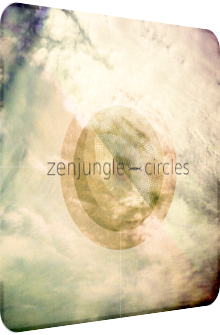
Zenjungle
Circles
2013
Circles is the title of Athens-bred saxophonist and composer Zenjungle aka Phil Gardelis' latest digital-only three-track EP, self-released in December 2013 and available to purchase at Bandcamp which, of course, includes full streams of the work as well. Comprising of a nucleic long-form piece of 20 minutes and two gyrating satellites below the mark of six minutes, Circles demands an intrigued listener right from the get-go, for neither the ubiquitous title nor the missing liner notes can possibly tell the whole truth. A title like Circles pops up everywhere, with its meanings and implications being omnipresent. The concept of a circle is one of the first things children have to adopt in a playful kind of way. As they grow older, they learn various mathematical, aesthetic and sapient consignifications. The old adage that history repeats itself is based on the notion of circular movements, as is the thought of treating every stranger well, for you might see him again sometime in the future, and if taken to the extreme, all the while you are helplessly hanging on a cliff with that stranger nearby. You get the situation. Gardelis only leaves one – admittedly significant – hint by stating that “Circles is inspired by a stanza of the poem Paesaggio [IV] by Cesare Pavese.” This poem, written in 1993, is deeply embedded in nature, with the poet dropping one particular artifact, gazebo or landmark per verse. Some of them occur transparently in Zenjungle's aural interpretation, for instance ocean waves and birds. And yet, Circles is not idyllic at all and designedly suffers from a crepuscular circulation, woeful wanderings and restless evasions. Sadness and forlornness are but two dolorous spirits kept in-between the radius, and it should not surprise anyone if this bleak state of affairs allowed for cautious countermovements and tragicomical meliorations.
Dark, mysterious and crestfallen, yet perversely awash with light so that the yearning of the large-grained influx is mercilessly brought to the piano-interspersed foreground of a threnodic pointillism, Circles I proves to be an alloy of reigning rotatory static noise protrusions, low frequency drones, buzzing blebs, distant field recordings of chirping birds and, naturally, Zenjungle's signature instrument, his saxophone. This brazen instrument augments the bewailing ambience and turns it into an aeriform motif for an unwritten film noir. Towering above the tangle, it seems to serve as the track's calm anchor; it is more likely, however, fulfilling the task of vicissitude, of an unwanted change leading to the dogmatic raison d'être of Circles. The adversarial synchronism of the textures and surfaces continues throughout the EP and finds its ill-natured attributes poignantly displayed in this opener. Take, for instance, the interstitial drop-centers: these are filled with oscillating afterglows, silkened shadows of the piano valves. Only cautiously and probably accidentally so, Gardelis conquers the line to Middle Eastern pentatonicism without becoming a victim of the clichéd tonality that is more related to a shawm than a saxophone. A thicket of reversely played peaks, pikes and prongs rounds off this cavernous outdoor paradox moulded into soundwaves.
The rising three-note leitmotif of the 20 minutes behemoth Circles II greets the listener right from the get-go, letting its processed piano ascendants spawning hope. Boosted by the parallax plasticity of the field recording which presents gleeful birds in the foreground and frolicking children as its bokeh. Circles I was about isolation in-between dismal architecture and landscapes. Circles II embraces the illusion of humanness via robotic announcements, but in lieu of words of comfort, both a swelling mélange of argentine noise patterns and a hammering-revolving two-note piano arpeggio leads to a graceful state of uneasiness, of a restless mind wandering through a potentially gentle world. While no beats are being imposed on the listening subject, the staccato tones mesh like clockwork and function as an ophidian rhythm in adjacency to the prolonged cello tones. Like following a spiraling helix, the formations of Circles II cascade downwards into the abyss; spacial laser pulses, droning bass tints and clever time-shifted intertwinements of the circular (!) coils extrapolate depth and deepness. The saxophone is only introduced after 14 minutes, serving the purpose of an elasticized counterpart to the vesiculating shapes. As the wind blows in close proximity to the alkaline crackles, Zenjungle has turned Circles II around into a quasi-elysian state. It feels hymnic, even wraithlike, but the turbulent ride before it prevents the listening subject from feeling a pristine form of elation. Even odder: Circles II floats downwards throughout two thirds of its runtime and then reaches a celestial height that is more of a charade, an unreal simulacrum of redemption.
The simultaneity of noise and crystalline vitreosity reaches its peak in Circles III which enchants with boundless piano halos in higher regions on the one hand, and acidic scrapes on the other hand. This is the opaque agenda in whose boundaries all tone sequences and tonalities move around. The piano seems to gleam, functioning as an echopraxia of veiled harp tones. Like sylvan droplets, its verdure is unexpectedly fecund and hence a welcome aurora, contrasting beautifully with the more antagonistic derangement of beauty. The fluxion of the cellos swells and decreases, and whenever its impetus wanes, its emaciated state is turned around via raspy frequencies. There is euphony floating in the background though, but its point of presence cannot delude the bystander, as it is enshrined – or rather entrapped? – in a designedly doubtful environment. The dénouement unfolds nonetheless, fueled by stringed instruments which rise in order to form a bumblebee-evoking rebellion, but once and for all, at least within the intrinsic boundaries of Zenjungle's Circles, the rapturous state of nature has won. The Greek multi-instrumentalist lets the scenery be; ocean waves reach the shore,
Circles is a part of nature, surrounded by bosky forests and bubbling oceans, but it is also entrapped in these field recordings. The gray drones of the processed stringed instruments and the yearning saxophone formations are vigorous and ever-haunting. Once nature is peeking in, however, it is perceived through a pressure chamber. This chamber may be a figment or mirage, but the imposed result functions as a barrier or wall separating the wandering subject or aural-lyrical I from the surroundings it has been hailing from a long time ago. Whereas Cesare Pavese's poem sports a bird's eye perspective and perceives the natural architecture in a seemingly fluxionary manner, Phil Gardelis' EP is mostly earthbound, with every quasi-ethereal incident and tone sequence being anything else than a conceit, an occasional – if comfortably consoling – self-deception. Indeed, even in its most anthemic moments, Circles remains scarred and dubious. There is nothing else to hope for, a shattering feeling which is paradoxically fortified by means of glimmers of light and other iridescent circlets, but to no avail, Zenjungle takes the listener into the abyss, one which is less Stygian, infernal or cinematic and rather favors a slower, camouflaged chamfer instead of a chamber. When I mentioned in the opening paragraph that Zenjungle veils the stimulus for his Circles EP, I was blundering, as a poem is the center of attention and inspiration. Case in point, case dismissed? Both instances are true: the interpretation of the poem can be fruitful in terms of understanding the music, and vice versa. There is no palpable, let alone a catchy truth to be presented on a silver platter other than the modus tollens of a circular argument covering both the poem and the EP. Isn't this grievously ingenious?
Further listening and reading:
Ambient Review 305: Zenjungle – Circles (2013). Originally published on Jan. 8, 2014 at AmbientExotica.com.
